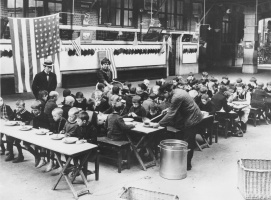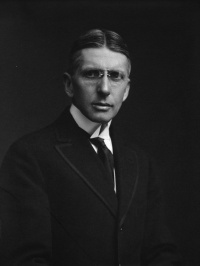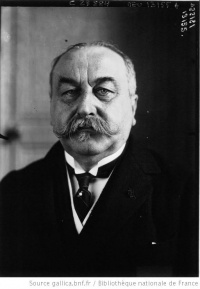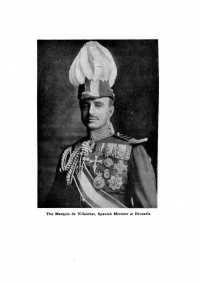International and National Efforts↑
The Comité national de Secours et d’Alimentation (National Committee for Relief and Food) was created in Brussels in September 1914 – a few days after the Germans arrived in the city – by a group of politicians, industrialists and financers. Belgium was highly dependent on food imports and international trade. The destruction of livestock caused by the invasion, the requisitions ordered by the German army and the blockade imposed by the British navy, threatened to plunge occupied Belgium into mass starvation. On 16 October 1914, the Governor General of occupied Belgium, Field Marshal Colmar von der Goltz (1843-1916), formally accepted to shield the foodstuff imported by the Committee from military requisitioning. Fortified by this guarantee, the Committee sent a delegation to London to negotiate with the British authorities. Led by Emile Francqui (1863-1935), a Belgian businessman and head of the executive committee, the delegation obtained an agreement permitting food imports via the Netherlands. Great Britain would probably not accept allowing food to pass through its naval blockade without the help of a neutral organization: the Commission for Relief in Belgium (CRB). Created by an American mining engineer living in England, the future president of the United States, Herbert C. Hoover (1874-1964), the CRB opened its offices in London on 22 October 1914.
A close cooperation was established between the Committee and the CRB. The CRB raised money throughout the world through charitable appeals and subsidies from the Belgian and Allied governments. With this money, it had to buy food from around the world and transport these foodstuffs to the Netherlands. From Rotterdam, the goods were conveyed by canal into occupied Belgium. With the assistance of the ambassadors of the United States, Spain and the Netherlands, the delegates of the CRB in Belgium guaranteed that imported stuff did not benefit the Germans.
In occupied Belgium, the National Committee organised a very effective system of food distribution. Provincial and local committees were established everywhere and food shops opened in each town and in many villages. The foodstuffs imported by the CRB were sold in these shops. The National Committee and all its local agencies (organised at the provincial level and in more than 2,000 cities and villages) consisted in fact of two separate bodies: a “food department” in charge of commercial operations and also for sustaining a “relief department”. With the money generated by the sale of the imported foodstuffs, the Committee subsidised its relief work. All forms of relief were taken on: aid to the unemployed, families of soldiers and children, etc. At the end of the war, the Committee worked with an estimated 125,000 agents. Present in the life of millions of Belgians and in the absence of the legal government (exiled in Le Havre), it played the role of a second government. Nevertheless, the Committee preserved its status of informal organisation. This informal non-status sheltered it from control by the Germans. Relations between the Belgian government in exile and the Committee were sometimes strained, but they were nonetheless maintained throughout the war.
Tensions↑
The Committee was regularly in conflict with the occupation regime. Requisitions of native foodstuffs led to incessant controversy. From 1915, the occupier tried to forbid the Committee from granting aid to some workers refusing to work for the German war effort. The Committee was forbidden to give instructions to official local authorities or to exert pressure on them without the approval of the Germans. Despite many tensions and suspicions, the Germans tolerated the Committee throughout the war. For them, this organisation offered the advantage of lessening the burden of feeding the Belgian population and permitted them to avoid major food riots or other disruptions that might have arisen otherwise. The price to pay was to deal with an organization that symbolized resistance to the occupying power while maintaining a minimal sense of hope and confidence among the Belgian population.
The Committee expended its activities throughout the occupation. In April 1915, it was allowed to extend its operations to the occupied regions of Northern France via a subcommittee called Comité d’Alimentation du Nord de la France (Food Committee for Northern France). At the same time, it attracted many voluntary relief organisations into its orbit. From 1917, the Committee was able to offer access to some form of assistance to each inhabitant of Belgium (soup kitchens, clothing workshops, medical aids, infant care, etc.) Despite these efforts, the Committee faced criticism during the second half of the war. It failed to stop the continuous rise of food prices caused by scarcity and many Committee agents were accused of fraud and favoritism. First a symbol of national unity, the Committee could not avoid the emergence of some political cleavages within its ranks. Socialists denounced the difficulties the organization had while attempting to have a role in some of its local committees. Pre-war notables played a central role and were often not ready to give up their seats to women or people not from traditionally elite circles. The relief practises of the Committee were sometimes also marked by a form of paternalism and moralism inherited from pre-war charities. Women of ill repute and people who went to the cinemas or the pubs were sometimes stricken off of the relief rolls. Some aid was granted not merely on the basis of need but also on the basis of merit.
Conclusion↑
With the help of the CRB, the Committee organised the food supply and various social aid mechanisms in occupied Belgium until the end of the war. Born from a private initiative, it imposed itself nevertheless as a sort of provisional government and symbolised the permanence of Belgian institutions in the context of the occupation. Four years of war worsened the living conditions of the vast majority of the Belgian population, but the Committee’s incessant efforts to distribute food and relief allowed the country to avoid the worst. Tensions never paralysed the Committee’s action and contributed to the restoration of Belgian public authorities after the war. This experience had a huge influence on post-war Belgium. For the first time, socialists had been involved in very important decisions, and in a way this was the party’s entry into national Belgian politics. This collaboration between conservatives and progressives opened the way to very important political and social reforms in the immediate post-war period. The Committee fostered the formation of a government of national union and gave rise to the emergence of new politicians who played a significant role in post-war Belgium, like Léon Delacroix (1867-1929), who was prime minister from November 1918 to November 1920. Finally, it is important to note that during the last year of the war almost the entire Belgian population had access to some form of assistance for the first time since the war had begun. In many aspects, the mechanisms implemented by the Committee precluded the welfare state created three decades later.
Michaël Amara, National Archives of Belgium
Section Editor: Emmanuel Debruyne
Selected Bibliography
- Henry, Albert: L'oeuvre du Comité National de Secours et d'Alimentation pendant la guerre, Brussels 1920: Office de publicité.
- Lancken, Oscar von der / Amara, Michaël / Roland, Hubert (eds.): Gouverner en Belgique occupée. Oscar von der Lancken-Wakenitz. Rapports d'activité 1915-1918, Brussels 2004: P.I.E.-Peter Lang.
- Nath, Giselle: Brood willen we hebben! Honger, sociale politiek en protest tijdens de Eerste Wereldoorlog in Belgie (We want bread! Hunger, social policies and protest during the First World War), Antwerpen 2013: Manteau.
- Ranieri, Liane: Emile Francqui, ou, L'intelligence créatrice 1863-1935, Paris; Gembloux 1985: Duculot.











